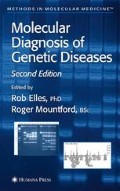Abstract
Automated fluorescent sequencing is often overlooked as a point mutation scanning technique usually on the grounds of cost, technical complexity, and difficulties in processing the information generated. However, sequencing cannot be avoided completely, because regardless of the mutation scanning technique employed, it must ultimately be used for mutation characterization.
Access this chapter
Tax calculation will be finalised at checkout
Purchases are for personal use only
References
Sanger, F., Nicklen, S., and Coulson, A. R. (1977) DNA sequencing with chainterminating inhibitors. Proc. Natl. Acad. Sci. USA 74, 5463–5467.
Bonfield, J. K., Rada, C., and Staden, R. (1998) Automated detection of point mutations using fluorescent sequence trace subtraction. Nucleic Acids Res. 26, 3404–3409.
Mattocks, C., Tarpey, P., Bobrow, M., and Whittaker, J. (2000) Comparative sequence analysis (CSA): a new sequence-based method for the identification and characterization of mutations in DNA. Hum. Mutation 16, 437–443.
International Human Genome Sequencing Consortium (2001) Initial sequencing and analysis of the human genome. Nature 409, 860–931.
Wallace, A. J., Wu, C. L., and Elles, R. G. (1999) Meta-PCR: a novel method for creating chimeric DNA molecules and increasing the productivity of mutation scanning techniques. Genetic Testing 3, 173–183.
Ewing, B. and Green, P. (1998) Base-calling of automated sequencing traces using Phred. II. Error probabilities. Genome Res. 8, 186–194.
Ewing, B., Hillier, L., Wendl, M. C., and Green, P. (1998) Base-calling of automated sequencing traces using Phred. I. Accuracy assessment. Genome Res. 8, 175–185.
Author information
Authors and Affiliations
Editor information
Editors and Affiliations
Rights and permissions
Copyright information
© 2004 Humana Press Inc.
About this protocol
Cite this protocol
Wallace, A.J. (2004). Mutation Scanning for the Clinical Laboratory. In: Elles, R., Mountford, R. (eds) Molecular Diagnosis of Genetic Diseases. Methods in Molecular Medicine™, vol 92. Humana Press, Totowa, NJ. https://doi.org/10.1385/1-59259-432-8:81
Download citation
DOI: https://doi.org/10.1385/1-59259-432-8:81
Publisher Name: Humana Press, Totowa, NJ
Print ISBN: 978-0-89603-932-2
Online ISBN: 978-1-59259-432-0
eBook Packages: Springer Protocols

